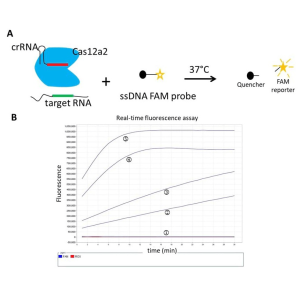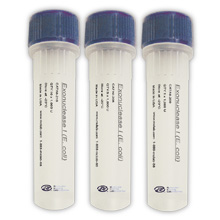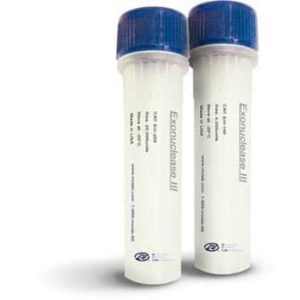-
Enzymes, Nucleases
Benzonase Endonuclease
Benzonase endonuclease from Serratia marcescens, can be used to degrade all forms of DNA and RNA while having no proteolytic activity.
-
CRISPR/Cas12a System, Nucleases
Cas12a Nuclease
CRISPR-Cas systems are powerful tools for mediating nucleic acids. Cas12a (also referred as Cpf1) nuclease belonging to the Class 2, Type V CRISPR system.
-
CRISPR/Cas12a2 System, Enzymes, Gene Editing, Nucleases
Cas12a2 Nuclease
CRISPR-Cas systems are powerful molecular tools for mediating nucleic acids. Cas12a2, a Type V CRISPR/Cas nuclease, cleaves the target RNA following target RNA recognition by the complementary crRNA.
-
CRISPR/Cas13 System, Enzymes, Gene Editing, Nucleases
Cas13a (CRISPR Associated Protein 13a)
Adaptive immune systems from prokaryotes utilize clustered regularly interspaced short palindromic
repeats (CRISPRs) and CRISPR associated (Cas) proteins to cleave foreign genetic material. Cas13a, (previously referred to as C2c2) is part… -
CRISPR/Cas13 System, Enzymes, Gene Editing, Nucleases
Cas13d
Adaptive immune systems from prokaryotes utilize clustered regularly interspaced short palindromic
repeats (CRISPRs) and CRISPR-associated (Cas) proteins to cleave foreign genetic material. Cas13d is part of the Type VI CRISPR-Cas system. -
CRISPR/Cas9 System, Enzymes, Gene Editing, Nucleases
Cas9 Nuclease
Cas9 Nuclease, Streptococcus pyogenes, is an RNA-guided endonuclease that catalyzes site-specific cleavage of double stranded DNA.
-
CRISPR/Cas13 System, Enzymes, Gene Editing, Nucleases
dCas13a
Adaptive immune systems from prokaryotes utilize clustered regularly interspaced short palindromic
repeats (CRISPRs) and CRISPR associated (Cas) proteins to cleave foreign genetic material. Cas13a, (previously referred to as C2c2) is part… -
CRISPR/Cas13 System, Enzymes, Gene Editing, Nucleases
dCas13d
Adaptive immune systems from prokaryotes utilize clustered regularly interspaced short palindromic repeats (CRISPRs) and CRISPR-associated (Cas) proteins to cleave foreign genetic material. Cas13d is part of the Type VI CRISPR-Cas…
-
Enzymes, Nucleases
Exonuclease I (E. coli)
Exonuclease I cleaves single-stranded DNA in the 3′→ 5′ direction, releasing 5′ -mono/di-nucleotides and leaving double-stranded DNA molecules and the 5′-terminus intact.
-
Enzymes, Nucleases
Exonuclease III (E. coli)
Exonuclease III is a 3′→ 5′ exonuclease which acts by digesting one strand of a dsDNA duplex at a time or digesting the RNA strand of an RNA-DNA heteroduplex (1).
-
Enzymes, Nucleases
Exonuclease VII
Exonuclease VII, (Exo VII) derived from E. coli, cleaves single-stranded DNA (ssDNA) from both 5´→3´ and 3´→5´ directions.




